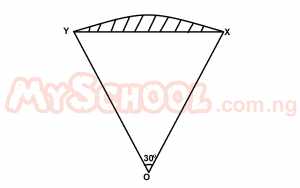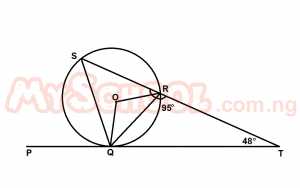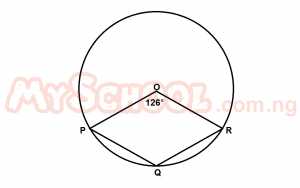Year :
1992
Title :
Mathematics (Core)
Exam :
WASSCE/WAEC MAY/JUNE
Paper 1 | Objectives
11 - 20 of 48 Questions
| # | Question | Ans |
|---|---|---|
| 11. |
Write as a single fraction \(\frac{1}{1 - x} + \frac{2}{1 + x}\) A. \(\frac{x + 3}{1 - x^2}\) B. \(\frac{3 - x}{(1 - x)^2}\) C. \(\frac{3 - x}{1 + x^2}\) D. \(\frac{3 - x}{(1 + x)^2}\) E. \(\frac{3 - x}{1 - x^2}\) Detailed Solution\(\frac{1}{1 - x} + \frac{2}{1 + x}\)= \(\frac{(1 + x) + 2(1 - x)}{(1 - x)(1 + x)}\) = \(\frac{1 + x + 2 - 2x}{1 - x^2}\) = \(\frac{3 - x}{1 - x^2}\) |
|
| 12. |
What must be added to the expression x\(^2\) - 18x to make it a perfect square? A. 3 B. 9 C. 36 D. 72 E. 81 Detailed Solutionx\(^2\) - 18x to be a perfect square.\((\frac{b}{2})^2\) is added to ax\(^2\) + bx + c in order to make it a perfect square. \(x^2 - 18x + (\frac{-18}{2})^2\) = \(x^2 - 18x + 81\) |
|
| 13. |
Solve the equation \(\frac{m}{3} + \frac{1}{2} = \frac{3}{4} + \frac{m}{4}\) A. -3 B. -2 C. 2 D. 3 E. 4 Detailed Solution\(\frac{m}{3} + \frac{1}{2} = \frac{3}{4} + \frac{m}{4}\)\(\frac{m}{3} - \frac{m}{4} = \frac{3}{4} - \frac{1}{2}\) \(\frac{m}{12} = \frac{1}{4}\) \(4m = 12 \implies m = 3\) |
|
| 14. |
The angle of a sector of a circle of radius 8cm is 240°. This sector is bent to form a cone. Find the radius of the base of the cone. A. 16/3cm B. 15/3cm C. 16/5cm D. 8/3cm E. 16/10cm Detailed SolutionL = θ/360 x 2πR = 240/360 x 2 x 22/7 x 8/1 ... (1)This must be equal to the circumference of the circle which is 2πr = 44R/7 .... (2) equate (1) and (2) r = 16/3 = 51/3 |
|
| 15. |
The curved surface area of a cylindrical tin is 704cm\(^2\). Calculate the height when the radius is 8cm. [Take π = 22/7] A. 3.5cm B. 7cm C. 14cm D. 28cm E. 32cm Detailed SolutionCurved surface area of a cylindrical tin = \(2\pi rh\)\(\therefore 2\pi rh = 704cm^2\) \(2 \times \frac{22}{7} \times 8 \times h = 704\) \(h = \frac{704 \times 7}{2 \times 22 \times 8}\) \(h = 14cm\) |
|
| 16. |
The volume of a cone of height 9cm is 1848cm\(^3\). Find its radius. [Take π = 22/7] A. 7cm B. 14cm C. 28cm D. 98cm E. 196cm Detailed Solution1/3 πr\(^2\) x 9 = 18483 x πr2 = 1848 r2 = 1848/3 x 7/22 r = 14 \(\text{Volume of a cone} = \frac{1}{3} \pi r^2 h\) \(\frac{1}{3} \times \frac{22}{7} \times r^2 \times 9 = 1848\) \(r^2 = \frac{1848 \times 7}{22 \times 3}\) \(r^2 = 196 \therefore r = 14cm\) |
|
| 17. |
The area of a parallelogram is 513cm\(^2\) and the height is 19cm. Calculate the base. A. 13.5cm B. 25cm C. 27cm D. 54cm E. 108cm Detailed SolutionArea of parallelogram = base \(\times\) height.\(513 = base \times 19 \implies base = \frac{513}{19}\) = 27 cm |
|
| 18. |
 The diagram above shows the shaded segment of a circle of radius 7cm. if the area of the triangle OXY is 12\(\frac{1}{4}\)cm\(^2\), calculate the area of the segment A. 5/12cm2 B. 7/12cm2 C. 11/6cm2 D. 2 1/3cm2 E. 6 1/6cm2 Detailed SolutionArea of \(\Delta OXY\) = \(12\frac{1}{4} cm^2\)Area of sector OXY = \(\frac{30}{360} \times \frac{22}{7} \times 7 \times 7\) = \(\frac{77}{6} = 12\frac{5}{6} cm^2\) Area of the shaded portion = \(12\frac{5}{6} - 12\frac{1}{4}\) = \(\frac{7}{12} cm^2\) |
|
| 19. |
 In the diagram above PQT is a tangent to the circle QRS at Q. Angle QTR = 48° and ∠QRT = 95°. Find ∠QRT A. 48o B. 45o C. 37o D. 32o E. 30o Detailed Solution∠RQT = 180° - (95° + 48°) = 73°∠OQR = 90° - 37° = 53° ∠QOR = 180° - (53° + 53°) = 74° QSR = 74°/2 = 37° |
|
| 20. |
 In the diagram above, O is the center of the circle and ∠POR = 126°. Find ∠PQR A. 234o B. 117o C. 72o D. 63o E. 54o Detailed SolutionReflex < POR = 360° - 126° = 234°\(\therefore\) < PQR = \(\frac{1}{2} \times 234°\) = 117° |
| 11. |
Write as a single fraction \(\frac{1}{1 - x} + \frac{2}{1 + x}\) A. \(\frac{x + 3}{1 - x^2}\) B. \(\frac{3 - x}{(1 - x)^2}\) C. \(\frac{3 - x}{1 + x^2}\) D. \(\frac{3 - x}{(1 + x)^2}\) E. \(\frac{3 - x}{1 - x^2}\) Detailed Solution\(\frac{1}{1 - x} + \frac{2}{1 + x}\)= \(\frac{(1 + x) + 2(1 - x)}{(1 - x)(1 + x)}\) = \(\frac{1 + x + 2 - 2x}{1 - x^2}\) = \(\frac{3 - x}{1 - x^2}\) |
|
| 12. |
What must be added to the expression x\(^2\) - 18x to make it a perfect square? A. 3 B. 9 C. 36 D. 72 E. 81 Detailed Solutionx\(^2\) - 18x to be a perfect square.\((\frac{b}{2})^2\) is added to ax\(^2\) + bx + c in order to make it a perfect square. \(x^2 - 18x + (\frac{-18}{2})^2\) = \(x^2 - 18x + 81\) |
|
| 13. |
Solve the equation \(\frac{m}{3} + \frac{1}{2} = \frac{3}{4} + \frac{m}{4}\) A. -3 B. -2 C. 2 D. 3 E. 4 Detailed Solution\(\frac{m}{3} + \frac{1}{2} = \frac{3}{4} + \frac{m}{4}\)\(\frac{m}{3} - \frac{m}{4} = \frac{3}{4} - \frac{1}{2}\) \(\frac{m}{12} = \frac{1}{4}\) \(4m = 12 \implies m = 3\) |
|
| 14. |
The angle of a sector of a circle of radius 8cm is 240°. This sector is bent to form a cone. Find the radius of the base of the cone. A. 16/3cm B. 15/3cm C. 16/5cm D. 8/3cm E. 16/10cm Detailed SolutionL = θ/360 x 2πR = 240/360 x 2 x 22/7 x 8/1 ... (1)This must be equal to the circumference of the circle which is 2πr = 44R/7 .... (2) equate (1) and (2) r = 16/3 = 51/3 |
|
| 15. |
The curved surface area of a cylindrical tin is 704cm\(^2\). Calculate the height when the radius is 8cm. [Take π = 22/7] A. 3.5cm B. 7cm C. 14cm D. 28cm E. 32cm Detailed SolutionCurved surface area of a cylindrical tin = \(2\pi rh\)\(\therefore 2\pi rh = 704cm^2\) \(2 \times \frac{22}{7} \times 8 \times h = 704\) \(h = \frac{704 \times 7}{2 \times 22 \times 8}\) \(h = 14cm\) |
| 16. |
The volume of a cone of height 9cm is 1848cm\(^3\). Find its radius. [Take π = 22/7] A. 7cm B. 14cm C. 28cm D. 98cm E. 196cm Detailed Solution1/3 πr\(^2\) x 9 = 18483 x πr2 = 1848 r2 = 1848/3 x 7/22 r = 14 \(\text{Volume of a cone} = \frac{1}{3} \pi r^2 h\) \(\frac{1}{3} \times \frac{22}{7} \times r^2 \times 9 = 1848\) \(r^2 = \frac{1848 \times 7}{22 \times 3}\) \(r^2 = 196 \therefore r = 14cm\) |
|
| 17. |
The area of a parallelogram is 513cm\(^2\) and the height is 19cm. Calculate the base. A. 13.5cm B. 25cm C. 27cm D. 54cm E. 108cm Detailed SolutionArea of parallelogram = base \(\times\) height.\(513 = base \times 19 \implies base = \frac{513}{19}\) = 27 cm |
|
| 18. |
 The diagram above shows the shaded segment of a circle of radius 7cm. if the area of the triangle OXY is 12\(\frac{1}{4}\)cm\(^2\), calculate the area of the segment A. 5/12cm2 B. 7/12cm2 C. 11/6cm2 D. 2 1/3cm2 E. 6 1/6cm2 Detailed SolutionArea of \(\Delta OXY\) = \(12\frac{1}{4} cm^2\)Area of sector OXY = \(\frac{30}{360} \times \frac{22}{7} \times 7 \times 7\) = \(\frac{77}{6} = 12\frac{5}{6} cm^2\) Area of the shaded portion = \(12\frac{5}{6} - 12\frac{1}{4}\) = \(\frac{7}{12} cm^2\) |
|
| 19. |
 In the diagram above PQT is a tangent to the circle QRS at Q. Angle QTR = 48° and ∠QRT = 95°. Find ∠QRT A. 48o B. 45o C. 37o D. 32o E. 30o Detailed Solution∠RQT = 180° - (95° + 48°) = 73°∠OQR = 90° - 37° = 53° ∠QOR = 180° - (53° + 53°) = 74° QSR = 74°/2 = 37° |
|
| 20. |
 In the diagram above, O is the center of the circle and ∠POR = 126°. Find ∠PQR A. 234o B. 117o C. 72o D. 63o E. 54o Detailed SolutionReflex < POR = 360° - 126° = 234°\(\therefore\) < PQR = \(\frac{1}{2} \times 234°\) = 117° |